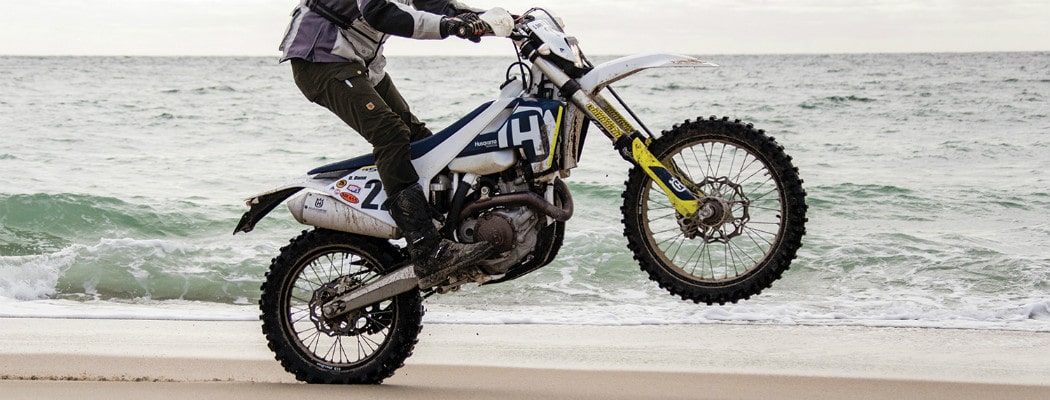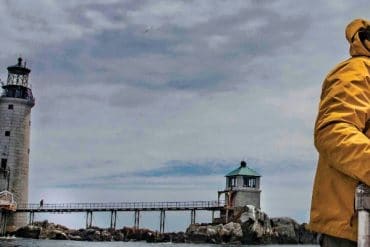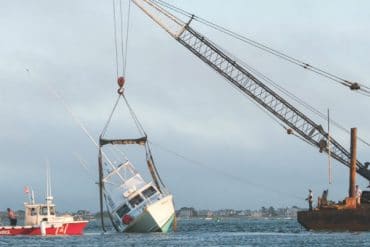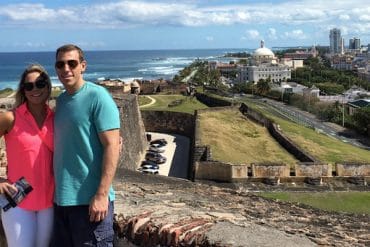From Madaket to Mexico, one man’s mission to survive the world’s most dangerous motorcycle race.
In the pantheon of motor racing, few contests compare to the Baja 1000. Covering around a thousand miles through the Mexican desert, where vigilante spectators are infamous for setting booby traps to ensnarl drivers, the Baja 1000 is widely considered to be the single most dangerous off-road race in the world. Since its founding in 1967, the race has lured NASCAR legends, stuntmen, motor heads, adrenaline junkies—everyone from Steve McQueen to Mario Andretti—to test their mettle amid the dust of the Baja desert. Souped-up cars, trucks, ATVs, buggies and motorcycles—some costing millions of dollars—set out on a largely unmarked course for up to thirty-four hours. Most teams split up the journey, with drivers switching off every couple hundred miles as chase helicopters hover overhead. The ultimate gauntlet, however, what’s known as the Ironman, is for a single driver to race all those miles alone on a motorcycle. And that’s exactly what Nantucket native Dave Dunn set out to do this November.
 Dave Dunn doesn’t fit the mold of a motorcycle racer, certainly not the breed of testosterone-fueled alpha males buzzing through Baja each November. The soft-spoken thirty-year-old grew up on Nantucket and works as one of the managers of the Sconset Casino. “Country club life certainly doesn’t translate to high-speed desert racing,” he quips.
Dave Dunn doesn’t fit the mold of a motorcycle racer, certainly not the breed of testosterone-fueled alpha males buzzing through Baja each November. The soft-spoken thirty-year-old grew up on Nantucket and works as one of the managers of the Sconset Casino. “Country club life certainly doesn’t translate to high-speed desert racing,” he quips.
Dunn first learned about the Baja 1000 at the age of fifteen when he rented a documentary called Dust to Glory from the old video store on Orange Street. “That movie was truly otherworldy for me,” he said. “Here I was a kid living on an island in New England watching a race through a desert in Mexico.” Dunn racked up a string of late fees and watched the movie obsessively, dreaming of one day competing in the race himself. Now, fifteen years later, his dream is finally coming true.
“There’s definitely a type of person who races motorcycles who is a little more aggressive than I am,” says Dunn, who will be competing in the professional motorcycle category. “I was always intimidated by that, but eventually I just forced myself to do it because this has always been a dream of mine.” His mild temperament aside, what makes Dunn an even more unlikely competitor for the Baja 1000 is his training ground. After all, how does one prepare to ride a motorcycle for a thousand miles through the desert—what amounts to manning a jackhammer for twenty-four hours—on a tiny island like Nantucket?
 “The terrain here is obviously much different than the desert and there’s only so many rideable miles,” Dunn describes, “but we’re lucky to have a motocross track out by the airport.” Along with the track and lifting weights at the Sconset Casino gym, Dunn has trained by riding his fully-loaded motorcycle along the beaches, through the Moors and up and down Milestone Road while wearing a weighted vest. Off the island, he has competed in hour-long “Hair Scrambles,” as well as criss-crossing the country six times. Yet, no matter how many hours he logs on the island or off, there’s only so much he can do to prepare for the most lawless race on the planet.
“The terrain here is obviously much different than the desert and there’s only so many rideable miles,” Dunn describes, “but we’re lucky to have a motocross track out by the airport.” Along with the track and lifting weights at the Sconset Casino gym, Dunn has trained by riding his fully-loaded motorcycle along the beaches, through the Moors and up and down Milestone Road while wearing a weighted vest. Off the island, he has competed in hour-long “Hair Scrambles,” as well as criss-crossing the country six times. Yet, no matter how many hours he logs on the island or off, there’s only so much he can do to prepare for the most lawless race on the planet.
The course for the Baja 1000 changes from year to year, either running in a loop or a point-to-point for a distance ranging between 700 and 1,200 miles. Always starting in Ensenada, Mexico, the course snakes across the Baja peninsula, connecting stretches of desert wilderness with open highways where everyday traffic is allowed to drive among the racers. “High-speed desert racing is dangerous—people have died,” Dunn says. “There’s eight hundred miles of chances of getting lost. They mark the course with arrows, but those arrows could get booby trapped.”
As if driving a motorcycle for upwards of thirty-four hours across ditches, through deep sand, around cactuses and stray dogs, and amid commuter traffic wasn’t hard enough, ill-mannered spectators are known to sabotage drivers for the joy of watching them crash. “There is a contingency of people who just want to see you crash and burn,” he says, “but I’m hoping it’s not as pervasive as it has been made to seem.”
 The coordinates for this year’s course—a 799.1-mile loop beginning and ending in Ensenada—were released in mid-October. Pouring over Google Earth in his home on Nantucket, Dunn had to not only familiarize himself with the route, but also plot out his pit stops. “This isn’t like NASCAR or some other kind of motor race in a contained course,” Dunn explains. “It takes place through the desert where you need to plan where you’re getting fuel, changing tires—you need to figure out all the logistics.”
The coordinates for this year’s course—a 799.1-mile loop beginning and ending in Ensenada—were released in mid-October. Pouring over Google Earth in his home on Nantucket, Dunn had to not only familiarize himself with the route, but also plot out his pit stops. “This isn’t like NASCAR or some other kind of motor race in a contained course,” Dunn explains. “It takes place through the desert where you need to plan where you’re getting fuel, changing tires—you need to figure out all the logistics.”
While Dunn will be the only one manning his motorcycle during the race, he has assembled a five-man support team that will trail him along the way. Nantucket native and lifelong childhood friend Jason Sibley-Liddle will serve as Dunn’s team manager while Greg Nearhood, whom Dunn first explored Baja with two years ago, will drive one of the support vehicles. A retired Union Pacific Railroad engineer named Rick Hoffman will serve as the crew chief, while Nantucket-based photographer Jonathan Nimerfroh will document all the action with his camera. Rounding out Dunn’s team, which he has dubbed Mystery Moto Racing, is his wife, Emily Dunn, who will serve as his race coordinator.
 Dunn proposed to Emily during a cross-country motorcycle adventure two years ago. She shares in his love of speed, the roar of an engine and the thrills found on the open road. Nevertheless, Dunn admits, “she is petrified but knows this is something that has meant a lot to me for a long time.” So it is that on November 24, as most families are preparing to sit down for their Thanksgiving dinners, Dunn will be straddling his motorcycle in the Mexican desert, finally fulfilling his childhood dream.
Dunn proposed to Emily during a cross-country motorcycle adventure two years ago. She shares in his love of speed, the roar of an engine and the thrills found on the open road. Nevertheless, Dunn admits, “she is petrified but knows this is something that has meant a lot to me for a long time.” So it is that on November 24, as most families are preparing to sit down for their Thanksgiving dinners, Dunn will be straddling his motorcycle in the Mexican desert, finally fulfilling his childhood dream.








